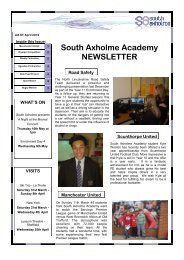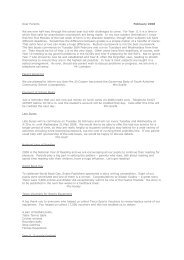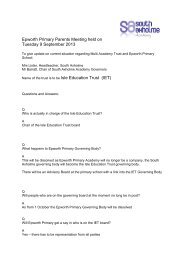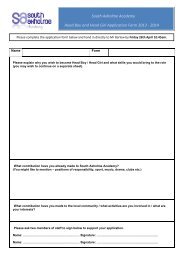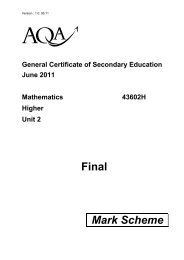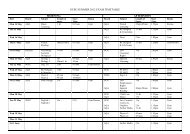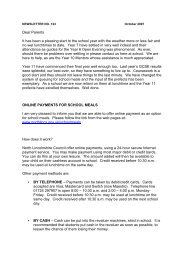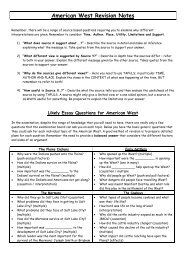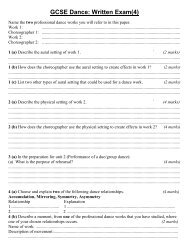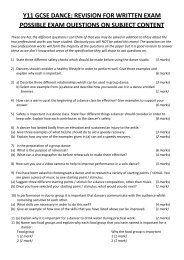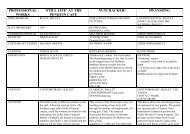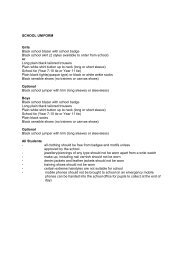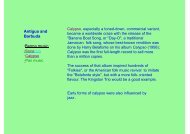Ballroom Dances (19th Century) Waltz 1) People ... - South Axholme
Ballroom Dances (19th Century) Waltz 1) People ... - South Axholme
Ballroom Dances (19th Century) Waltz 1) People ... - South Axholme
Create successful ePaper yourself
Turn your PDF publications into a flip-book with our unique Google optimized e-Paper software.
<strong>Ballroom</strong> <strong>Dances</strong> (<strong>19th</strong> <strong>Century</strong>)<br />
<strong>Waltz</strong><br />
1) <strong>People</strong> first started writing and dancing waltzes in Austria -<br />
mostly in the ballrooms of Vienna.<br />
2) The first waltzes were written in the 1790's. The most<br />
famous composers were the family of Strausses. (The dad d<br />
was Johann Strauss the Elder. He had three sons who all<br />
composed waltzes - Johann, Josef and Eduard.)<br />
3) The waltz ended up being one of the most popular dances<br />
of the nineteenth century - not just in Vienna, but all over<br />
Europe and in North thAmerica too.<br />
4) <strong>People</strong> thought the waltz was really saucy at first - it was<br />
the first dance where people held each other so closely.
<strong>Ballroom</strong> <strong>Dances</strong> (<strong>19th</strong> <strong>Century</strong>)<br />
<strong>Waltz</strong><br />
1) <strong>People</strong> first started writing and dancing waltzes in - mostly<br />
in the<br />
of Vienna.<br />
2) The first waltzes were written in the . The most<br />
famous composers were the<br />
. (The dad was<br />
Johann Strauss the Elder. He had three sons s who all composed<br />
waltzes - Johnann, Josef and Eduard.)<br />
3) The waltz ended up being one of the most popular dances of the<br />
nineteenth th century - not tjust tin Vienna, but all over<br />
and in North America too.<br />
4) <strong>People</strong> thought the waltz was really saucy at first - it was the<br />
first dance where people held each other so closely.<br />
Austria 1790's Europe <strong>Ballroom</strong>s Strausses
<strong>Ballroom</strong> <strong>Dances</strong> (<strong>19th</strong> <strong>Century</strong>)<br />
<strong>Waltz</strong><br />
Answers<br />
1) <strong>People</strong> first started t writing and ddancing waltzes in Austria-<br />
mostly in the <strong>Ballroom</strong>s of Vienna.<br />
2) The first waltzes were written in the 1790's .Themost<br />
famous composers were the Strausses . (The dad was<br />
Johann Strauss the Elder. He had three sons who all composed<br />
waltzes - Johnann, Josef and Eduard.) d 3) The waltz ended up being one of the most popular dances of the<br />
nineteenth century - not just in Vienna, but all over Europe<br />
and in North America too.<br />
4) <strong>People</strong> thought the waltz was really saucy at first - it was the first<br />
dance where people held each other so closely.<br />
l
The Rhythm goes 'Oom Cha Cha, Oom Cha Cha'<br />
1) A waltz is always in triple metre. The time signature is usually<br />
3/4.<br />
2) The 'oom' is stronger than the 'cha cha', so the rhythm feels<br />
more like one beat in a bar than three.<br />
3) The 'oom cha cha' rhythm is emphasised in the accompanying<br />
chords.<br />
4) <strong>Waltz</strong>es written for dancing have a steady, constant beat.<br />
<strong>Waltz</strong>es for listening often have pauses and use tempo rubato. (The<br />
beat of the music' pulled about - some bits go faster, some slower.)
The Chords are simple and don't change much<br />
A waltz has a strong clear tune, closely backed by the chords. It's<br />
called a homophonic texture.<br />
1) The chords are pretty simple - mostly they're primary chords I,<br />
IV, V.<br />
2) The same chord's used for at least one bar, and sometimes for<br />
two or four bars.<br />
3) One note of the chord's playedonthe'oom.' oom. On the 'cha cha'<br />
the rest of the notes are played together, or the whole chord's<br />
played.<br />
4) The speed of chord changes in called the harmonic rhythm.<br />
<strong>Waltz</strong> chords change slowly, so waltzes have slow harmonic<br />
rhythm.<br />
5) The slow, simple chord pattern can get a bit repetitive, so<br />
composers use appoggiaturas and chromatic notes to spice up<br />
their tunes.
The Rhythm goes 'OOm Cha Cha, Oom Cha Cha' TRUE or FALSE<br />
1) A waltz is always in duple metre.<br />
2) A waltz is always in triple metre.<br />
3) The time signature is usually 4/4.<br />
4) The time signature is usually 3/4.<br />
5) The 'oom' is stronger than the 'cha cha', so the rhythm feels more like<br />
one beat in a bar than three.<br />
6) The 'oom cha cha' rhythm is emphasised in the accompanying chords.<br />
7) <strong>Waltz</strong>es written for listening have a steady, constant beat.<br />
8) <strong>Waltz</strong>es written for dancing have a steady, constant beat.<br />
9) <strong>Waltz</strong>es for listening often have pauses and use tempo rubato.
ANSWERS<br />
The Rhythm goes 'OOm Cha Cha, Oom Cha Cha' TRUE or FALSE<br />
1) A waltz is always in duple metre. FALSE<br />
2) A waltz is always in triple metre. TRUE<br />
3) The time signature is usually 4/4. FALSE<br />
4) The time signature is usually 3/4. TRUE<br />
5) The 'oom' is stronger than the 'cha cha', so the rhythm feels more like<br />
one beat in a bar than three. TRUE<br />
6) The 'oom cha cha' rhythm is emphasised in the accompanying chords.<br />
7) <strong>Waltz</strong>es written for listening have a steady, constant beat. FALSE<br />
8) <strong>Waltz</strong>es written for dancing have a steady, constant beat. TRUE<br />
9) <strong>Waltz</strong>es for listening often have pauses and use tempo rubato. TRUE
The Chords are simple and don't change much<br />
1) A waltz has a strong clear tune, closely backed by the chords. It's<br />
called a polyphonic texture.<br />
2) The chords are pretty simple - mostly they're primary chords I, IV, V.<br />
3) The same chord's used for at least one bar, and sometimes for two<br />
or four bars.<br />
4) One note of the chord's played on the 'oom.' On the 'cha cha' the<br />
rest of the notes are played together, or the whole chord's played.<br />
5) The speed of chord changes is called the harmonic rhythm. <strong>Waltz</strong><br />
chords change really fast, so waltzes have fast harmonic rhythm.<br />
6) The slow, simple chord pattern can get a bit repetitive, so<br />
composers use appoggiaturas and chromatic notes to spice up their<br />
tunes.
ANSWERS<br />
The Chords are simple and don't change much<br />
1) A waltz has a strong clear tune, closely backed by the chords. It's called<br />
a polyphonic texture. FALSE<br />
2) The chords are pretty simple - mostly they're primary chords I, IV, V.<br />
TRUE<br />
3) The same chord's used for at least one bar, and sometimes for two or<br />
four bars. TRUE<br />
4) One note of the chord's played on the 'oom.' On the 'cha cha' the rest of<br />
the notes are played together, or the whole chord's played. TRUE<br />
5) The speed of chord changes is called the harmonic rhythm. <strong>Waltz</strong> chords<br />
change really fast, so waltzes have fast harmonic rhythm. FALSE<br />
6) The slow, simple chord pattern can get a bit repetitive, so composers<br />
use appoggiaturas and chromatic notes to spice up their tunes. TRUE
<strong>Waltz</strong>es Started Simple and Ended Up Complex<br />
The first waltzes were written in binary with two 8-bar repeated sections<br />
SECTION A<br />
SECTION A<br />
repeated<br />
SECTION B<br />
SECTION B<br />
repeated<br />
Then pairs of waltzes were grouped together to make ternary form<br />
SECTION A SECTION A SECTION B SECTION B<br />
<strong>Waltz</strong> 1<br />
repeated repeated<br />
SECTION A SECTION A SECTION B SECTION B<br />
<strong>Waltz</strong> 2<br />
repeated<br />
repeated<br />
<strong>Waltz</strong> 1<br />
SECTION A<br />
SECTION A<br />
repeated<br />
SECTION B<br />
SECTION B<br />
repeated<br />
1) Joseph Lanner (another composer from Vienna) and Johan Strauss the Elder made waltzes<br />
even longer and more complex. They strung five or more waltz tunes together. Each tine last 16-<br />
32 bars and is in binary or ternary form. They also added slow introductions and codas.<br />
2) Johann (baby) Strauss wrote two of the most famous longer waltzes - The Blue Danube and<br />
Tales from the Vienna Woods.
<strong>Waltz</strong>es Were Played By Big Orchestras<br />
<strong>Waltz</strong>es and polkas were played by larger<br />
orchestras that were standard in the Romantic<br />
period.<br />
There's a lot of brass and woodwind, including<br />
more unusual instruments like piccolos. The<br />
percussion sections have a big variety of<br />
instruments, e.g. timpani, tambourine, triangle<br />
and snare drum.
<strong>Waltz</strong>es Spread Beyond the <strong>Ballroom</strong>s<br />
1) <strong>Waltz</strong>es crop up as dances and songs in operettas. Some of the<br />
more famous ones are by Johann Struass the Younger (Die<br />
Fledermaus) and Gilbert and Sullivan (Pirates of Penzance.)<br />
2) <strong>Waltz</strong>es were so popular in the <strong>19th</strong> century that people liked to<br />
play them at home on the piano. Chopin, Schumann, Brahms and<br />
Weber all wrote tons of waltzes for playing at home, as well as<br />
harder waltzes for concert pianists.<br />
i 3) Some nineteenth century composers included waltzes in their<br />
orchestral works, e.g. Berlioz's 'Symphonie Fantastique,'<br />
Tchaikovsky's s '4th and 5th Symphony' , and Ravel's 'La Valse. '<br />
Tchaikovsky put waltzes in his ballets too - 'Swan Lake' and<br />
'Sleeping Beauty' both include waltz tunes.<br />
4) In the twentieth century the waltz was used in a few musicals.<br />
There are waltzes in Cole Porter's 'High Society' and Rogers and<br />
Hammerstein's 'The Sound of Music.'
The Polka's Another Popular <strong>Ballroom</strong> Dance<br />
1) The polka hit the ballroom scene a bit later than the waltz, in<br />
the 1830s, but ended up just as popular.<br />
2) It was originally a folk song from Bohemia - that's the western<br />
part of the Czech Republic.<br />
3) The polka has a lot more energy and jerkier movements than<br />
a waltz. Partners hold tight and move quick-quick-slow. q<br />
4) There are 2 beats per bar and polkas are usually in 2/4. The<br />
polka rhythms often copy the dance movements.<br />
5) Just like waltzes, polkas were written in binary and ternary<br />
forms and composers used techniques like appoggiaturas to<br />
spice up the tunes.<br />
6) The baby Strausses wrote lots of polkas and fancy orchestral<br />
effects. The most famous are the Thunder and Lightning and<br />
Pizzicato Polkas.<br />
7) Like waltzes, polkas moved away from the ballroom and were<br />
used din classical lpieces, e.g. in Smetana's opera 'The Bartered<br />
Bride.'
The Polka's Another Popular <strong>Ballroom</strong> Dance<br />
1) The polka hit the ballroom scene a bit later than the waltz, in the , but<br />
ended up just as popular.<br />
2) It was originally a song from - that's the western part<br />
of the Czech Republic.<br />
3) The polka has a lot more and jerkier movements than a waltz..<br />
.<br />
4) There are per bar and polkas are usually in 2/4. The polka rhythms<br />
often copy the<br />
movements.<br />
5) Just like waltzes, polkas were written in binary and forms<br />
and composers used techniques like<br />
to spice up the tunes.<br />
6) The baby Strausses wrote lots of polkas and fancy orchestral<br />
The most famous are the Thunder and Lightning and Pizzicato Polkas.<br />
7) Like waltzes, polkas moved away from the and were used<br />
in classical pieces, e.g. in Smetana's opera 'The Bartered Bride.'<br />
ternary<br />
Bohemia<br />
dance<br />
2 beats<br />
effects<br />
energy<br />
folk<br />
quick-quick-slow<br />
appoggiaturas<br />
1830s
Answers<br />
The Polka's Another Popular <strong>Ballroom</strong> Dance<br />
1) The polka hit the ballroom scene a bit later than the waltz, in the 1830s , but<br />
ended up pjust as popular. p<br />
2) It was originally a folk<br />
song from Bohemia<br />
- that's the western part<br />
of the Czech Republic.<br />
3) The polka has a lot more energy and jerkier movements than a waltz.<br />
.<br />
4) There are 2 beats per bar and polkas are usually in 2/4. The polka rhythms<br />
often copy the dance movements.<br />
5) Just like waltzes, polkas were written in binary and ternary<br />
forms<br />
and composers used techniques like appoggiaturas to spice up the tunes.<br />
6) The baby Strausses wrote lots of polkas and fancy orchestral<br />
effects<br />
The most famous are the Thunder and Lightning and Pizzicato Polkas.<br />
quick-quick-slow<br />
7) Like waltzes, polkas moved away from the and were used<br />
in classical pieces, e.g. in Smetana's opera 'The Bartered Bride.'



